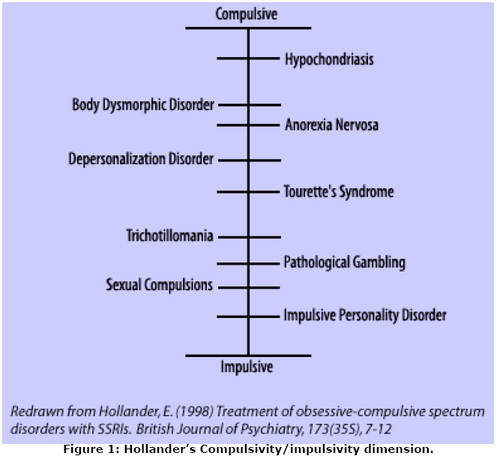In a review of an article by Blaszczynski, which explored the relationship between pathological gambling and obsessive-compulsive behavior, the WAGER 4(19) introduced the concept of obsessive-compulsive spectrum disorders. Blaszczynski found that pathological gamblers differed significantly from non-pathological gamblers on two obsessive-compulsive factors:
(1) Impaired control of mental activities; and (2) Losing control over motor behaviors. He proposed that future research determine the placement of pathological gambling on the impulsivity-compulsivity spectrum. His proposal has come about in two recent works by Stein (2000) and Bienvenue et al. (2000). Findings from an earlier work by Black et al. (1994) also have relevance to this discussion. Before looking at these works, we should review where pathological gambling currently resides on the impulsivity-compulsivity spectrum.
Hollander places pathological gambling on the “impulsive” end of the compulsivity-impulsivity or risk avoidance spectrum. He maintains that compulsive and impulsive disorders are similar in that they involve repetitive behaviors and a defect in the mechanism to inhibit or delay acting on these behaviors. But, he believes that the “driving mechanism” behind the behaviors is quite different. Compulsive individuals are risk-averse and harm avoiding; whereas, impulsive individuals are risk-taking and pleasure seeking. His concept of the obsessive-compulsive spectrum disorders and the compulsivity/impulsivity dimension is illustrated in Figure 1.
Stein reviews the neurochemistry, neuroanatomy, genetics, neuroimmunology, and animal models of OCD and concludes that, “Any attempt to develop the construct of an OCD spectrum perhaps underestimates the heterogeneity of OCD.” In his review of the neurochemistry of OCD spectrum disorders and the “serotonin hypothesis” he points out that pharmacotherapeutic dissection, or showing that different conditions have similar selective responses to medication, does not demonstrate that these conditions are the same. That would be the equivalent to saying that stubbed toe and arthritis lie along a spectrum because they both respond to aspirin. This mistake of using pharmacotherapeutic dissection to prove similarity has propagated throughout the literature of obsessive-compulsive disorders. For example, Bienvenue et al. note that the OCD spectrum disorders are similar to OCD in terms “response to selective pharmacologic or behavioral treatments” citing Hollander. Stein also concludes “…it is important not to underestimate the phenomenological and neurobiological contrasts [emphasis added] of such conditions [kleptomania and pathological gambling] with OCD and one another.
Bienvenue et al. hypothesized that OCD spectrum disorders should occur more often in case (OCD) probands and their first-degree relative than in control probands and their first-degree relatives. They compared the lifetime prevalence of obsessive compulsive spectrum conditions in 80 case probands and 343 of their first-degree relatives with their prevalence in 73 control probands and 300 of their first-degree relatives. Of the 423-odd case probands and first-degree relatives, one person (0.24%) was diagnosed with pathological gambling, and among the 373 or so control probands and their first-degree relatives, no one evidenced pathological gambling. Since the controls and their relatives were selected by random-digit dialing, we would expect a 1-2% prevalence of pathological gambling (Shaffer, Hall, & Vander Bilt, 1999), or about 4 to 8 persons. The expected prevalence of pathological gambling among those with OCD is perhaps 20% (Linden, 1986) or, 85 persons. Alternatively, if we use the 0 prevalence found by Black, no persons. Bienvenue et al. remark, “The evidence for familial cotransmission of certain impulse control disorders (i.e., kleptomania and pathological gambling, and pyromania) was particularly weak.” We might go so far as to conclude that OCD is protective in terms of being a pathological gambler.
Black et al. explored the relationship between OCD and two “compulsive” behaviors, eating disorders and pathological gambling. They hypothesized that if these disorders were linked to OCD, their frequency would be increased among relatives of those with OCD. Their study included 32 case probands and 120 of their first-degree relatives and 33 control probands and 129 of their first-degree relatives. They found no relatives with pathological gambling. They conclude “It may be that several of the so-called compulsive disorders are linked, such as alcoholism and pathological gambling, but at present there is no evidence to link them to OCD.”
Since these studies found no significant relationship between pathological gambling and OCD, perhaps we should consider further whether pathological gambling should be included in the OCD spectrum disorders.
References
Bienvenue, O. J., Samuels, J. F., Riddle, M. A., Hoehn-Saric, R., Liang, K. -Y., Cullen, B. A. M., Grados, M. A., & Nestadt, G. (2000). The relationship of obsessive-compulsive disorder to possible spectrum disorders: Results from a family study. Biological Psychiatry, Vol 48(4), 287-293.
Black, D. W., Goldstein, R. B., Noyes, R., & Blum, N. (1994). Compulsive behaviors and obsessive-compulsive disorder (OCD): Lack of a relationship between OCD, eating disorders, and gambling. Comprehensive-Psychiatry; 1994 Mar-Apr Vol 35(2) 145-148.
Blaszczynski, A. (1999). Pathological gambling and obsessive-compulsive spectrum disorders. Psychological Reports, 84, 107-133.
Hollander, E. (1998). Treatment of obsessive-compulsive spectrum disorders with SSRIs. British Journal of Psychiatry, 173(35S), 7-12.
Linden, R. D., Pope, J. H. G., & Jonas, J. M. (1986, April). Pathological gambling and major affective disorder: Preliminary findings. Journal of Clinical Psychiatry, 47(4), 201-203.
Shaffer, H. J., Hall, M. N., & Vander Bilt, J. (1999). Estimating the prevalence of disordered gambling behavior in the United States and Canada: a research synthesis. American Journal of Public Health, 89, 1369-1376.
Stein, D. J. (2000). Neurobiology of the obsessive-compulsive spectrum disorders. Biological Psychiatry, 47(4), 296-304.





